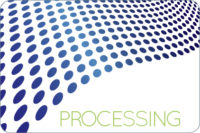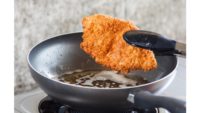Just by the nature of the work conducted in these locations, floor surfaces typically become coated with grease, oil, and raw materials such as shortening, butter, and oil during the course of the work day. According to a 2008 report by CNA Insurance, this is why the food-processing industry is particularly vulnerable to slip, trip and fall injuries. In fact, CNA reports that “unless good housekeeping practices are maintained, spilled ingredients can contaminate walking surfaces … leading to slips and falls on the production floor.”
Based on a percentage of all Worker’s Compensation Claims, the CNA report lists slips, trips and falls on the same floor level (meaning an even floor surface with no steps or stairs, such as a typical production floor) as the third most common type of accident resulting in worker injuries and compensation claims (see Figure 1). Further, based on a percentage of all claim dollars, slips, trips and falls on the same floor level again come in at No. 3 when analyzing the overall costs of employee injuries and compensation (see Figure 2).
|
FIGURE 1 The top five types of incidents that cause injuries in foodservice facilities based on Workers’ Compensation Claims are:
Source: CNA Insurance |
Combining both foodservice employees and workers in commercial restaurant settings the National Floor Safety Institute (NFSI) estimates that more than 3 million such workers are injured each year in the U.S. as a result of slip-and-fall accidents. Many of these accidents end in death, and the number of deaths caused by such accidents appears to be on the rise. In 1996, the Centers for Disease Control and Prevention (CDC) attributed 4,600 deaths to slip-and-fall accidents. Today, that number is closer to 17,000.
Considering these numbers and the fact that they are increasing, it is evident that finding ways to keep workers safe and reduce slips, trips and falls should be a key concern for every facility manager. As the CNA report indicated, proper housekeeping practices are an important way to do just that. In order to properly address this issue, however, managers must first get a better understanding of exactly what a slip-and-fall accident is and the different ways in which they occur.
Logistics of the slip-and-fall accident
Slip-and-fall accidents are not all the same. And for both medical and legal purposes, it is often important to identify the exact type of slip and/or fall that occurred when an accident has taken place.
A slip typically occurs when a person loses his or her balance when walking. As we walk, the muscles and tendons in our legs expand and contract. Our weight transfers from leg to leg, and our center of gravity (COG), located in the center of the body, helps keep us balanced. If there is an unexpected change in the floor surface, a foot can slip, our COG can be negatively impacted, and we may lose our balance. If we cannot correct ourselves quickly enough, a fall occurs.
This all seems fairly straightforward. However, things get a bit more complicated when we analyze a fall. Falls are typically classified using the following four categories:
- Slip-and-fall. This is when the COG is shaken after losing secure foot contact with the floor.
- Step-and-fall. This is when the floor surface unexpectedly changes height or there is an actual hole in the floor.
- Stump (Stub)-and-fall. Encountering an unseen or unexpected impediment or obstruction — a drain cover that has lifted or a mat that has curled, for instance — can result in a stump-and-fall. Stump-and-falls can also occur when someone walks over a “tacky” part of a floor.
- Trip-and-fall. A foreign object on the floor, such as a power cord or an unseen or unexpected step, can result in a trip-and-fall.
If the worker lands on a fleshy part of the body, injuries may be minimal or nonexistent. It is when we land on a bony part of the body that falls can be serious.
All four types of falls can result in injuries; however, slip-and-falls are typically the most common. Some slip-and-fall accidents can be blamed on poor lighting or inability to see around a blind corner. They also often occur because the worker was wearing improper footwear or did not pay attention to warning signage.
Cleaning and maintenance
As noted earlier, a key cause of slip-and-falls, especially in food-processing/service locations, is grease and oil build-up on the floor. This is supported by Russ Kendzior, founder of the NFSI. According to Kendzior, “In order to prevent slips and falls, a business has to have a strategy that deals with the cleaning and maintenance of its floors. It cannot put the responsibility on employees by [simply] suggesting they watch where they’re walking.”
|
FIGURE 2 The top five types of incidents shown as a percentage of total claim dollars are:
Source: CNA Insurance |
To do this, Kendzior advises managers to assess the type of soiling present on floors, as well as the tools and equipment used to clean them. For instance, according to Kendzior, a typical floor cleaning procedure — whether in a school, office, or foodservice/processing facility — generally involves regular sweeping and dust mopping of the floors; mopping the floors with a cleaning solution; and, where necessary, using some type of agitation to help loosen and remove soils, often referred to as “decking the floor.”
While this is a tried-and-true floor cleaning procedure, it has become common knowledge in the professional cleaning industry in the last few years that this is not always an effective or even healthy process for a variety of reasons. This is because as mops become soiled, they can actually begin to spread soils from one floor area to another. These soils can then become a slip-and-fall hazard, as can the cleaning solution residue that builds up in grout areas around ceramic and quarry tiles. When this happens, a slip-and-fall is more likely.
This build-up can occur even if the floor has a high coefficient of friction (COF), which is a common feature of floors in foodservice facilities. COF is a measurement used to determine how well a floor can help prevent a slip-and-fall accident. A COF of 0.5 or less is considered slippery; a COF of 0.5 or more is considered a safer floor.[i]
Fortunately, there are alternatives to traditional floor care. One option many foodservice facilities are now embracing is referred to as spray-and-vac cleaning systems. With these systems, cleaning solution is applied directly to the floor. After a few minutes of dwell time, which allows the chemicals to begin dissolving soils, the same areas are then power rinsed. This process provides the agitation necessary to loosen soils. Soils and cleaning solution can then be rinsed down floor drains or, to speed the cleaning process and make it healthier and more thorough, the same system can vacuum up soils and moisture.
Another option is what is known as a “crossover” cleaning system. These systems start with a trolley-bucket to which various add-on components can be attached. One of the most common such add-ons used on commercial floors is a dispense-and-vac system. This technology dispenses chemical solution directly onto floors. Floors are then deck brushed if necessary. The final step involves vacuuming up the used cleaning solution and soils.
What is noteworthy about both of these systems is that no mops are used in the process. This eliminates the possibility of spreading soils from one area to another and allows the cleaning solution to remain fresh throughout the cleaning process. Further, some of these systems have been tested and certified by the NFSI, meaning the use of these machines is proven to reduce the potential for slip-and-fall accidents.
For very large foodservice or processing facilities, other systems may prove more applicable. What is important is to find alternatives to conventional, mop-and-bucket floor-cleaning practices. While there is not much that can be done to prevent spills, oils and grease from building up on floor surfaces in commercial foodservice facilities, there are a number of measures that can be taken to help keep floors cleaner, healthier and safer, helping to prevent accidents and injuries and also cut costs.




Report Abusive Comment